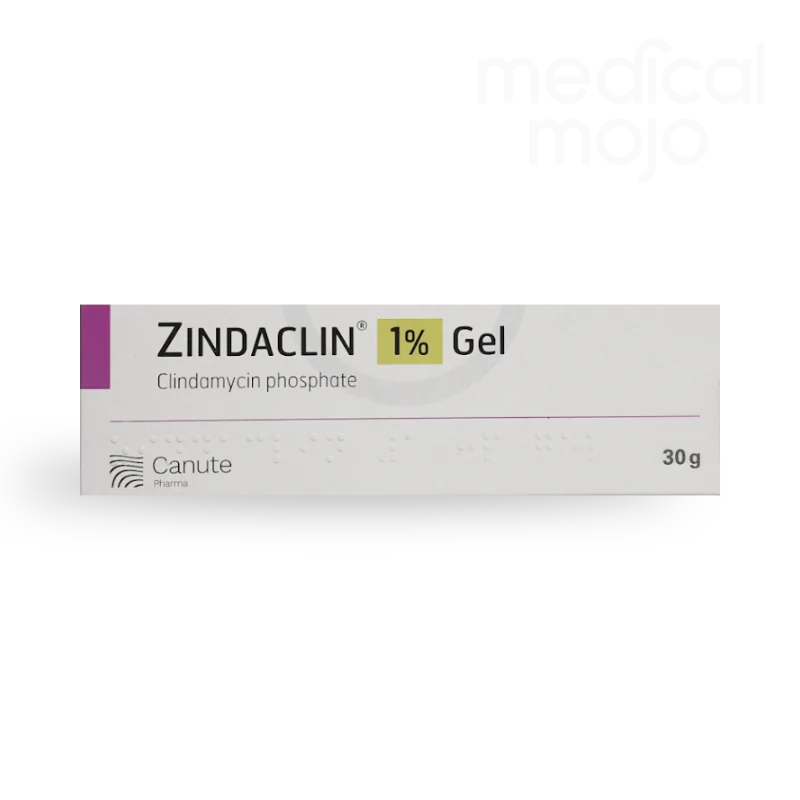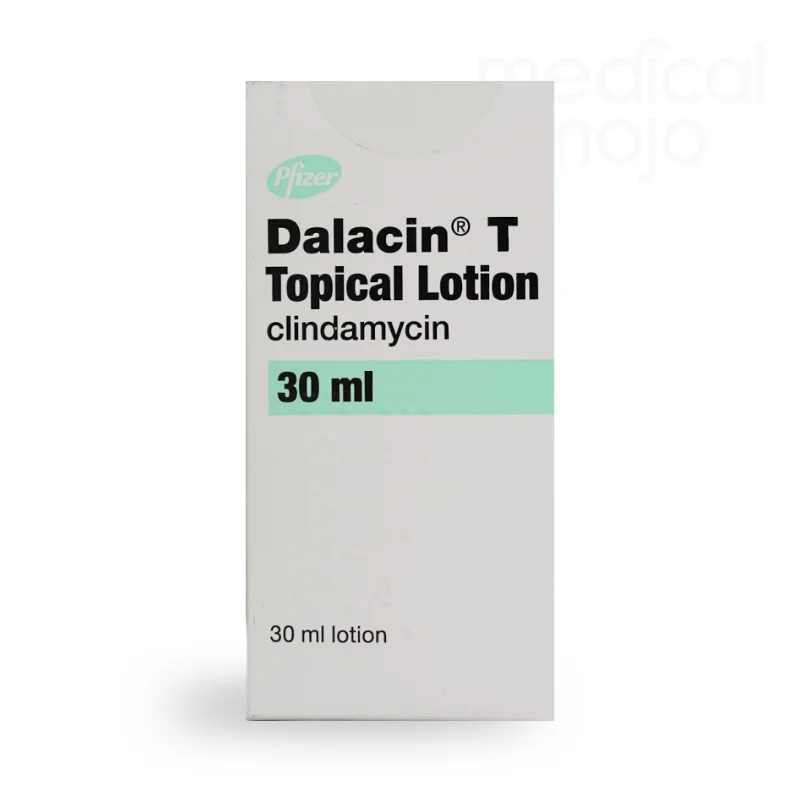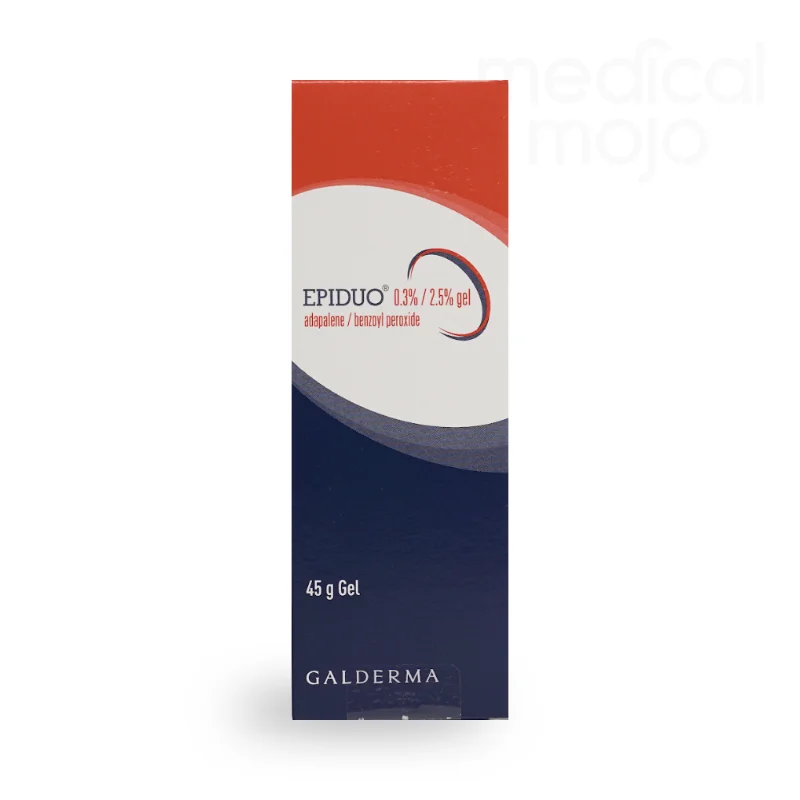Acne
Prescription-strength treatment for mild, moderate and severe acne
Acne treatments not working? Try compounding for bespoke acne solutions.
Personalised one on one coaching to identify the root cause of your acne.
Find the right acne treatment for you
View All ProductsWhat you should know about acne
Acne is primarily caused by clogged pores, excess oil production, bacteria, and inflammation. Hormonal changes, stress, diet, and certain medications can also contribute to acne development.
There are six main spots associated with acne: whiteheads, blackheads, pustules, papules, nodules and cysts.
To help prevent acne, maintain a skincare routine that includes gentle cleansing, avoid touching your face, use non-comedogenic products, and manage stress. Eating a balanced diet and staying hydrated can also help.
Common acne treatments include topical creams with benzoyl peroxide, salicylic acid, or retinoids, oral medications like antibiotics, and in some cases, hormonal treatments or isotretinoin for severe acne.
It typically takes 4 to 8 weeks to notice improvement from acne treatments. Consistent use and patience are key, as treatments may take time to fully clear the skin.
While research is ongoing, some evidence suggests that high-glycemic foods, dairy, and certain fats may trigger or worsen acne in some individuals.
Popping pimples is not recommended, as it can lead to scarring, infection, and increased inflammation, potentially worsening the acne.
If over-the-counter treatments are ineffective after several weeks, or if you have severe, painful acne that causes significant distress or scarring, it’s advisable to consult a dermatologist for personalized treatment options.
Additional information
What is acne?
Acne, also known as acne vulgaris, is a common skin condition that many of us have had an acquaintance with during our teenage years. Acne occurs when hair follicles become clogged with oil and dead skin cells. This can lead to the development of various types of blemishes, including blackheads, whiteheads, papules, pustules, nodules, and cysts. Acne, unfortunately, typically appears on the face, neck, chest, and back, and it is most prevalent during puberty due to hormonal changes. However, it can affect individuals at any age.
What causes acne?
Acne is not kind, and it strikes at a time in many people’s lives when they are going through huge changes. Yes, it’s that strange time when children start to develop into adults. During this time, the hormones are raging, playing havoc with emotions and judgement but also the skin. So, what causes these volcanic eruptions to break out over the skin?
It’s all about the sebum
Sebum is an oily substance produced by the body’s sebaceous glands whose main function is to keep the skin lubricated and skin hydrated. This means there is a film of oil coating the skin, preventing the loss of water and stopping the skin from drying out. You may have noticed that if you wash your hands with soap too much that you strip away this protective layer and your skin loses it’s natural suppleness, making it vulnerable. Remember, the skin is the first line of defence against bacteria that are just looking for an opportunity to invade the “all you can eat buffet” that your body provides. So the sebum creates this oily barrier keeping water in and the bugs out. However, as with all things in life, you can get too much of a good thing, and when there is too much sebum produced, it can mix with dead skin cells and form a plug that blocks hair follicles, causing acne to develop.
What is the difference between a whitehead and a blackhead?
Remember that blocked hair follicle? Well, depending on whether the follicle is blocked determines if a whitehead or blackhead develops. But we are getting ahead of ourselves, before we look at whiteheads and blackheads we need to define a technical word used a lot in acne, and that word is comedone. If you are anxious to know what a whitehead and blackhead are not interested in these comedone thingys, well spoiler alert they are the same thing.
What is a comedone?
A comedone is a type of acne lesion that occurs when a hair follicle (pore) becomes clogged with oil (sebum), dead skin cells, and other debris. Comedones are the primary feature of acne and can develop into different types depending on whether the pore remains open or closed.
- Open comedone: This is commonly known as a blackhead. In this case, the clogged pore remains open to the air, and the contents inside oxidize, turning dark or black. When thinking of things being oxidised just think of iron rusting when exposed to oxygen.
- Closed comedone: This is known as a whitehead. Here, the clogged pore is covered by a thin layer of skin, which traps the contents inside, leading to a white or flesh-colored bump.
Comedones can appear on the face, back, chest, and other areas with a high concentration of oil glands. They are often the first stage in the development of more severe acne types, such as papules, pustules, nodules, and cysts.
Bacteria and acne
Remember all those creepy bugs just waiting to invade, well they are also the reason that acne can become more severe. If bacteria start to infect these blocked follicles more severe spots like papules, pustules, nodules, or cysts can form.
Hormones and acne
Hormones are blamed for a lot of things these days, but usually it’s when older adults tend to run out of them leading people to start TRT and HRT. However, when these hormones flood the body in huge quantities during puberty, they cuase an increase in sebum production, and we all know where that ends up. Due to these wild hormone fluctuations explains why acne is so common among teenagers. It’s not just puberty that causes wild hormone swings and if you are lucky enough to be female you know all about these. Yes, I am referring to those monthly visits from Aunt Irma, or if you are not a fan of a certain comedy series, menstruation or periods. Another massive hormone disrupter and again we are talking to the women here, it’s pregnancy. It’s seems that woman are a getting the rough end of the stick but to all women out there you can take consolation that women generally tend to live longer than men. Kinda evens things out don’t you think.
Other factors thought to cause acne
Another factor thought to cause acne is stress. You can see how this factor is reinforced by acne, stress causes acne, acne causes stress, it’s one big vicious circle. Genetic factors are also important in determining the severity, duration and clinical pattern of acne. Although dismissed in the past as an urban myth, recent evidence suggests that diet can influence acne, with high glycaemic loads and excess dairy consumption aggravating severity. Other factors are the wild hormonal fluctuations which increase sebum production, leading to clogged pores and breakouts.
What are the symptoms of acne?
Well, they say a picture says a thousand words, so have a look below.
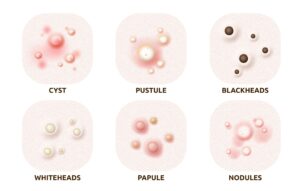
The main symptoms of acne include spots and oily skin. For most people, acne appears on the face and neck, and about half of sufferers also experience breakouts on their back. Only about 15% of people with acne develop spots on their chest. There are six main types of acne spots:
- Blackheads: Small bumps that appear black or yellowish due to pigmentation, not dirt.
- Whiteheads: Firm bumps that don’t empty when squeezed.
- Papules: Red bumps that are tender to the touch.
- Pustules: Red bumps with a white center filled with pus.
- Nodules: Large, hard lumps beneath the skin’s surface that can be painful.
- Cysts: Large, pus-filled bumps similar to boils that can lead to scarring.
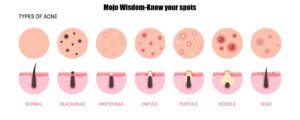
How is acne diagnosed?
Most cases of acne can be managed without seeing a doctor, as the symptoms are usually straightforward to identify and treat. However, even mild acne can cause emotional distress, and if your acne is affecting your well-being or if over-the-counter treatments aren’t working, it’s a good idea to consult a GP. If you have cysts or deep nodules, seeing a doctor is especially important to prevent potential scarring.
If you see a doctor, they will diagnose acne through a visual examination of the affected areas. They will assess the severity of your acne, which helps determine the best treatment approach. Acne severity is often categorized as follows:
- Mild acne (Grade 1): Mostly blackheads and whiteheads, with a few papules and pustules.
- Moderate acne (Grade 2): Multiple pustules and papules, primarily on the face.
- Moderate to severe acne (Grade 3): Many pustules and papules on the face, back, and chest, along with inflamed nodules.
- Severe acne (Grade 4): Numerous large, painful pustules and nodules.
If you’re an adult woman who suddenly develops acne, especially if accompanied by other symptoms like irregular periods or increased body hair, it’s important to see a doctor. These symptoms could indicate a hormonal imbalance, such as polycystic ovary syndrome (PCOS), which is a common cause of adult acne.
What are the best acne treatments available?
For moderate to severe acne, prescription treatments may be necessary, including:
- Topical retinoids (e.g., Differin, Isotrex) to reduce sebum production and prevent clogged pores.
- Oral antibiotics (e.g., Tetralysal/lymecycline, Oxytetracycline) used in combination with topical treatments to kill acne-causing bacteria.
- Topical antibiotics (e.g., Dalacin-T, Zineryt, Zindaclin) to reduce bacterial infection.
- Keratolytics (e.g., Acnecide) to remove dead skin cells.
- Azelaic acid (e.g., Skinoren) to promote skin cell turnover and reduce bacteria.
- Combination treatments (e.g., Duac Gel, Epiduo, Isotrexin, Treclin) that target multiple causes of acne.
All acne treatments should be used consistently for several months to see significant results.
Alternatives
Mild acne can often be managed with over-the-counter treatments containing benzoyl peroxide, which helps prevent clogged pores and kill bacteria. Products like Acnecide Gel (5% benzoyl peroxide) are applied to the skin after cleansing. However, be cautious, as benzoyl peroxide can bleach hair and fabrics.
Preventing Acne
While it’s difficult to prevent acne entirely, certain measures can reduce the risk of breakouts:
- Wash with a mild cleanser and avoid harsh scrubbing.
- Limit washing to twice a day to avoid irritation.
- Avoid touching your face to reduce the spread of bacteria.
- Keep hair clean and away from your face.
- Use non-comedogenic, water-based cosmetics and remove makeup before bed.
- Stay hydrated, eat a healthy diet, and manage stress.
BSc Pharmacy, Independent Prescriber, PgDip Endocrinology, MSc Endocrinology, PgDip Infectious Diseases
Superintendant Pharmacist, Independent Prescriber
MbChB, Coaching Academy diploma with distinction
GP, Medical coach
